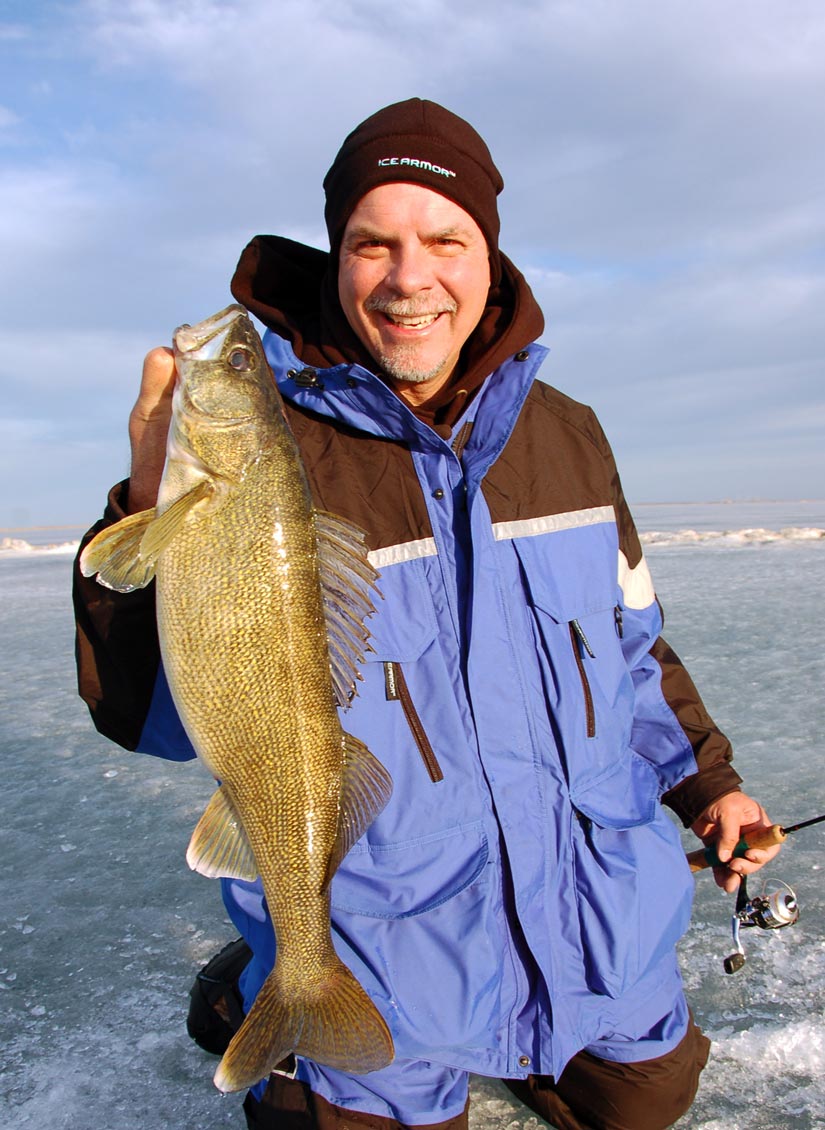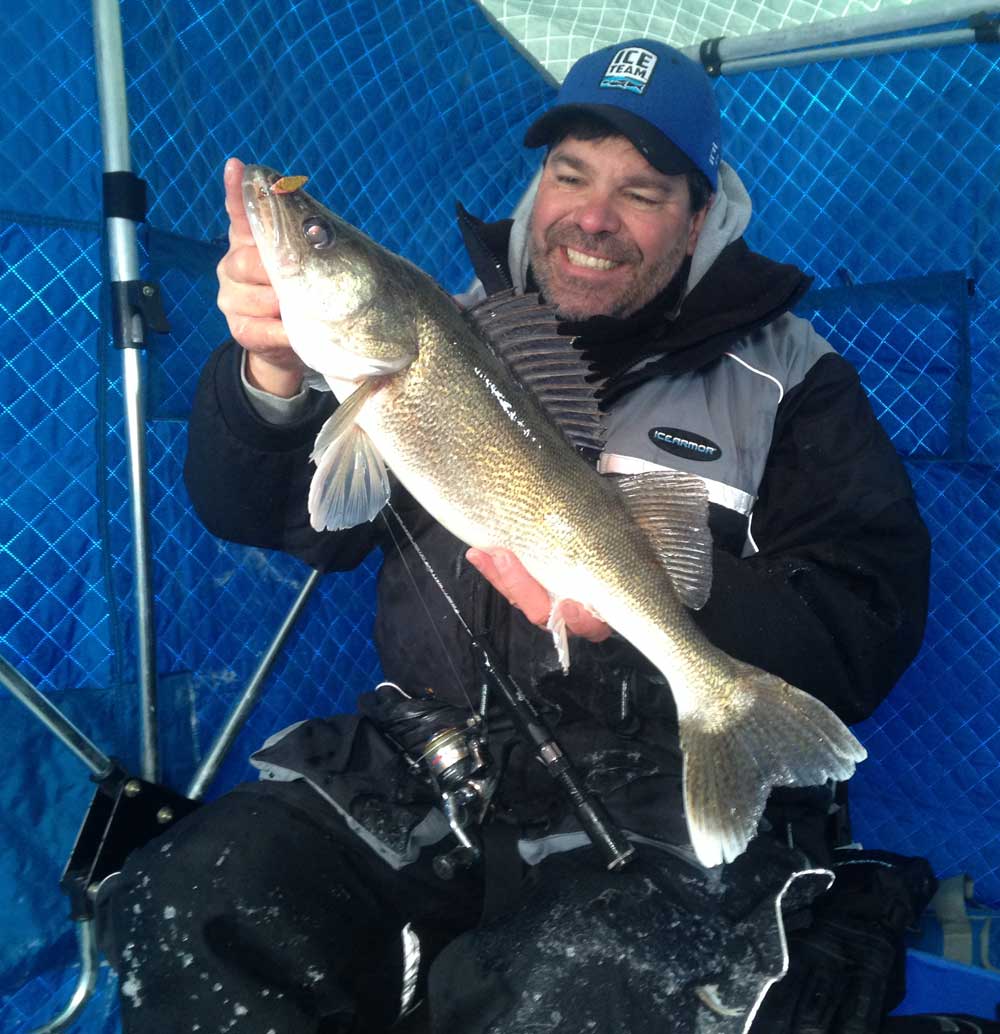 Have you stuck to your New Year’s resolutions so far? We figured out a long time ago that the secret to staying on course with a New Year’s resolution was to make it one you would be highly motivated to keep. In our case that’s relatively easy; as long as the resolution is to figure out more ways to catch more walleyes, we’re good to go. That’s also why this year’s resolution is especially exciting, as we resolved to catch more walleye ice fishing in January than we did last year. Now that may sound easy enough, but we had a pretty good year last year, so to better that success means we need to be even more efficient and effective in this season’s fishing. If you too would like to increase your catches through the ice, read on and see if our strategies can’t help you out too.
Have you stuck to your New Year’s resolutions so far? We figured out a long time ago that the secret to staying on course with a New Year’s resolution was to make it one you would be highly motivated to keep. In our case that’s relatively easy; as long as the resolution is to figure out more ways to catch more walleyes, we’re good to go. That’s also why this year’s resolution is especially exciting, as we resolved to catch more walleye ice fishing in January than we did last year. Now that may sound easy enough, but we had a pretty good year last year, so to better that success means we need to be even more efficient and effective in this season’s fishing. If you too would like to increase your catches through the ice, read on and see if our strategies can’t help you out too.
January can be a very interesting month when it comes to finding and catching walleyes. What makes it so interesting is that in most cases you’ll have good ice conditions over an entire lake (Obviously there can be exceptions to this so safety on the ice is always the first consideration). That means you have a lot more options for covering water (ice) than you did during the early ice period. You are not normally limited to being on foot, and can use ATVs, snowmobiles and even in some cases, trucks and cars, to get around the lake to check out prospective hot spots. This is when “mobility” really becomes the name-of-the-game on the ice.
We have found over the years that the best way to approach ice fishing this time of year is to attack it with the same attitude and energy that we would if it were a tough day of fishing during a summer walleye tournament. You need to hunt down the fish. Now keep in mind that during the winter you do have some obstacles you don’t normally deal with in the summer, first and foremost being that searching for walleyes with your electronics takes a bit more work. You need to concentrate your efforts on key structures and known “honey holes” if at all possible.
If this is a lake you fish during the summer months, chances are you probably already have some of the best spots marked on your map and/or GPS; key structures like humps, saddles and tapering points can all be worth checking out. Pay attention to transition areas where hard bottom changes to mud, and don’t ignore the larger feeding flats walleyes often use in the summer either as these can occasionally be real hot spots in the winter if you hit them at the right time.
Understand that when you drill holes and drop your transducer down to search, rarely will walleyes be instantly visible. Often, if you see any at all, they will be tight to the bottom. A quality locator/GPS combo like the Lowrance Elite-5 HDI mounted in the PPP-181 Ice Pack portable mount makes an ideal unit for viewing below the ice, and will help you distinguish fish that are belly-on-the-bottom. Always remember that even if spotting fish is difficult, locating schools of baitfish or even panfish can indicate you’re in an area worth sitting on for a bit.
Another key to mid-winter walleyes is that they can be notorious for being active only during the “dusk & dawn” periods, so in order to be as efficient as possible concentrate not only on location, but timing as well.
One of the most asked questions we get from ice anglers is, “How long do I work a spot before moving on?” This can be a tough call at times, but you want to be in a spot where you’re seeing activity either in the form of bites, or at least fish being drawn in to your presentations. We’re typically fishing with the mindset that we are going to have to fish hard for fewer bites. It’s a fine-line between sitting too long on a spot and jumping around too much to find active fish. A good rule-of-thumb is if you fish an area for 30 to 45 minutes with no action or no fish showing up on the locators, pack it up and move on. Patience is a virtue, but don’t get lazy about it either.
 We also are often asked if we jig for walleyes or use tip-ups. This again depends on what we find once we are on the ice for while. We don’t typically start off setting out tip-ups in an area unless it’s a spot we are real familiar with and know the general pattern for that area. Normally we start with a more “run & gun” system using jigging tactics with maybe a “dead stick” set-up close by. If after a time we feel we have located an area we can camp out on for a while then we may post some tip-ups around to cover the area thoroughly.
We also are often asked if we jig for walleyes or use tip-ups. This again depends on what we find once we are on the ice for while. We don’t typically start off setting out tip-ups in an area unless it’s a spot we are real familiar with and know the general pattern for that area. Normally we start with a more “run & gun” system using jigging tactics with maybe a “dead stick” set-up close by. If after a time we feel we have located an area we can camp out on for a while then we may post some tip-ups around to cover the area thoroughly.
Ice fishing rods now come in a wide range of actions and lengths. We like rods with a soft tip for good jigging action, but a good backbone for handling good sized fish. Rod length is often a big consideration. Longer ice fishing rods, in the 36 to 40 inch range, are great for fighting fish, but they are not very practical when you’re fishing in a small one-man portable shelter. For that reason, we like to hit the ice with both long and short rods so we can be effective both in a shelter and when fishing out in the open or in larger shelters.
A good line is essential when ice fishing. You need a line that will remain limp in the cold, yet stand up to the abuse of scraping along the ice during a fight. We like using Berkley Trilene 100% Fluorocarbon Professional Grade in 8 pound test. The Fluorocarbon is tough and abrasion resistant, yet its low visibility under water is key, especially it seems in ice fishing. Walleyes under the ice are just pickier than they are in warmer water, so the ultra-finesse of the low-vis line can make a big difference in the number of bites you get. We also like using 10 pound test Berkley Nanofil in the Low-Vis Green color, especially when fishing in waters where bigger walleyes are in the mix. But when using the Nanofil, we will add a 3 foot leader of the Fluorocarbon for a stealthier presentation.
As mentioned earlier, we like to jig, and the lure selection for jigging up walleyes runs the gamut from “old and reliable” to the newest on the market. Gary has carried a handful of old Acme Sidewinder spoons in his ice fishing arsenal for years, and tipped with a minnow head, they still catch a lot of walleyes. Clam’s new line-up of ice fishing tackle has some lures however that really have served us well recently. The Clam Blade Spoon has become a proven winner as has the unique Bomb Spoon. Again, we typically bait these with a minnow head. When we find ourselves in an area where big Perch are as plentiful as the walleyes, we like to tie on a Clam Speed Spoon. It’s a more “finesse” type spoon than the others, but works well on both walleyes and perch, and the opportunity to ice a nice bunch of fresh perch is something we will never turn down.
Ice fishing can be some of the most fun fishing you will ever experience, provided you go at it with the right attitude and the right plan. Just remember that a walleye is a walleye, whether the water is soft or covered with a sheet of ice. Do that, and you’ll be on the right track to getting your Next Bite.










